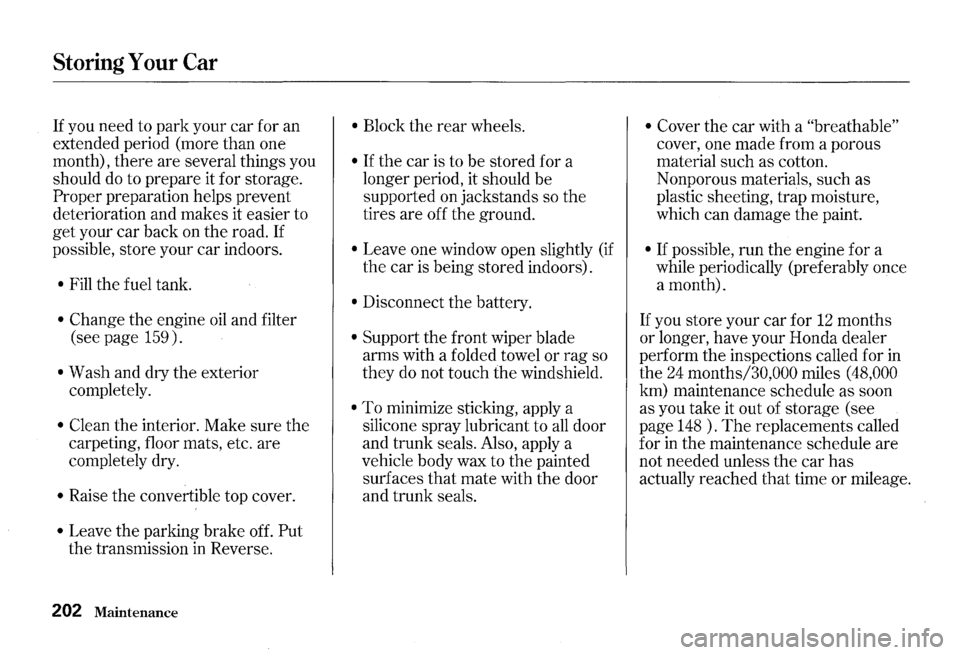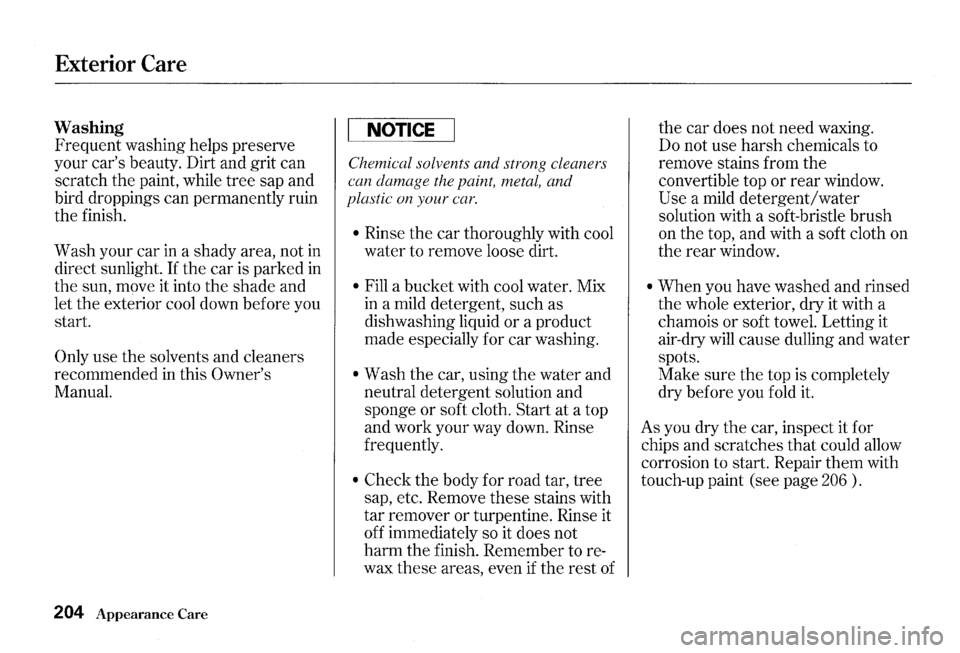Page 183 of 273
Wiper Blades
Check the condition of the wiper
blades at least every six months.
Look for signs of cracking in
the
rubber, or areas that are getting
hard. Replace
the blades if you find
these signs, or they leave streaks
and unwiped areas when used.
180 Maintenance
To replace the blade:
1. Raise the wiper arm off the
windshield.
2. Disconnect the blade assembly
from
the wiper arm by pushing in
the lock tab. Hold it in while you
push
the blade assembly toward
the base of the arm.
Page 205 of 273

Storing Your Car
If you need to park your car for an
extended period (more than one
month), there are several things you
should
do to prepare it for storage.
Proper preparation helps prevent
deterioration and makes it easier to
get your car back on the road.
If
possible, store your car indoors.
• Fill the fuel tank.
• Change the engine oil and filter
(see page 159).
• Wash and dry the exterior
completely.
• Clean the interior. Make sure the
carpeting, floor mats, etc. are
completely dry.
• Raise the convertible top cover.
• Leave the parking brake off. Put
the transmission in Reverse.
202 Maintenance
• Block the rear wheels.
• If the car is to be stored for a
longer period, it should be
supported on jackstands so the
tires are off the ground.
• Leave one window open slightly (if
the car is being stored indoors).
• Disconnect the battery.
• Support the front wiper blade
arms with a folded towel or rag so
they
do not touch the windshield.
• To minimize sticking, apply a
silicone spray lubricant to
all door
and trunk seals. Also, apply a
vehicle body wax to the painted
surfaces that mate with the door
and trunk seals.
• Cover the car with a "breathable"
cover, one made from a porous
material such as cotton.
Nonporous materials, such as
plastic sheeting, trap moisture,
which can damage
the paint.
• If possible, run the engine for a
while periodically (preferably once
a month).
If you store your car for 12 months
or longer, have your Honda dealer
perform the inspections called for
in
the 24 months/30,000 miles (48,000
km) maintenance schedule as soon
as you take it out of storage (see
page
148 ). The replacements called
for
in the maintenance schedule are
not needed unless the car has
actually reached that time or mileage.
Page 207 of 273

Exterior Care
Washing
Frequent washing helps preserve
your car's beauty. Dirt and grit can
scratch the paint, while tree sap and
bird droppings can permanently ruin
the finish.
Wash your car
in a shady area, not in
direct sunlight. If the car is parked in
the sun, move it into the shade and
let the exterior cool down before you
start.
Only use the solvents and cleaners
recommended
in this Owner's
Manual.
204 Appearance Care
NOTICE
Chemical solvents and strong cleaners
can
damar;e the paint, metal, and
plastic on your car.
• Rinse the car thoroughly with cool
water to remove loose dirt.
• Fill a bucket with cool water. Mix
in a mild detergent, such as
dishwashing liquid or a product
made especially for car washing.
• Wash the car, using the water and
neutral detergent solution and
sponge or soft cloth.
Start at a top
and work your way down. Rinse
frequently.
• Check the body for road tar, tree
sap, etc. Remove
these stains with
tar remover or turpentine. Rinse it
off immediately so it does not
harm the finish. Remember to re
wax these areas, even
if the rest of the
car does not need waxing.
Do not use harsh chemicals to
remove stains from the
convertible top
or rear window.
Use a mild detergent/water
solution with a soft-bristle brush
on the top, and with a soft cloth on
the rear window.
• When you have washed and rinsed
the whole exterior, dry it with a
chamois or soft towel. Letting it
air-dry
will cause dulling and water
spots.
Make sure the top is completely
dry before you fold
it.
As you dry the car, inspect it for
chips and scratches that could allow
corrosion to start. Repair
them with
touch-up paint (see page
206 ).
Page 211 of 273

Interior Care, Corrosion Protection
Windows
Clean the windows, inside and out,
with a commercially-available glass
cleaner. You can also use a mixture
of one part white vinegar to ten parts
water.
This will remove the haze that
builds up on the inside of the
windows.
Use a soft cloth or paper
towels to clean all glass and clear
plastic surfaces.
208 Appearance Care
Air Fresheners
If you want to use an air freshener I
deodorizer in the interior of your car,
it is best to use a solid type.
Some
liquid air fresheners contain chemi
cals that may cause parts of the
interior trim and fabric to crack or
discolor.
If you use a liquid air freshener,
make sure you fasten it securely so it
does not spill as you drive.
Corrosion Protection
Two factors normally contribute to
causing corrosion
in your car:
1. Moisture trapped in body cavities.
Dirt and road salt
that collects in
hollows on the underside of the
car stays damp, promoting
corrosion
in that area.
2. Removal of paint and protective
coatings from
the exterior and
underside of the car.
Page 214 of 273

Taking Care of the Unexpected
This section covers the more
common problems
that motorists
experience with their vehicles.
It
gives you information about how to
safely evaluate the problem and what
to
do to correct it. If the problem has
stranded you on the side of the road,
you may be able to get going again.
If not, you will also find instructions
on getting your car towed. Compact
Spare Tire .......................
212
Changing a Flat Tire ..................... 213
If Your Engine Won't Start ........... 218
Nothing Happens or the
Starter Motor
Operates
Very
Slowly ......................... 218
The Starter Operates
Normally ................................. 219
Jump Starting ................................. 220
If Your Engine Overheats ............. 223
Low Oil Pressure Indicator .......... 226
Charging System Indicator.. .........
227
Malfunction Indicator Lamp ........ 228
Brake System Indicator ................ 229
Closing the Convertible Top ........ 230
Fuses ............................................... 231
Checking and Replacing ........... 232
If Your Car Gets Stuck. ................. 236
Emergency Towing ....................... 238
Taking Care of the Unexpected 211
Page 221 of 273

If Your Engine Won't Start
Diagnosing why your engine won't
start falls into two areas, depending
on what you
hear when you press
the ENGINE START button.
• You hear nothing, or almost
nothing.
The engine's starter
motor does not operate at
all, or
operates very slowly.
• You can hear the starter motor
operating normally, or the starter
motor sounds like it is spinning
faster than normal, but the engine
does not start up and run.
218 Taking Care of the Unexpected
Nothing Happens or the Starter
Motor Operates Very Slowly
When you press the ENGINE
START button, you do not hear the
normal noise of the engine trying to
start. You may hear a clicking sound
or series of clicks, or nothing at
all.
Check these things:
• Your car has the Immobilizer
System.
You should use a
properly-coded master or valet key
to start the engine (see page 59).
A key that
is not properly coded
will cause the immobilizer system
indicator
in the dash panel to blink
rapidly.
• Turn the ignition switch to ON (II).
Turn on the headlights and check
their brightness.
If the headlights
are very dim or don't light at
all,
the battery is discharged. See
Jump Starting on page 220.
• Press
the ENGINE START button,
then release
it. If the headlights do
not dim, check the condition of the
fuses.
If the fuses are 0 K, there is
probably something wrong with
the electrical circuit for the
ignition switch
or starter motor.
You
will need a qualified
technician to determine the
problem.
(See Emergency
Towing on page 238 .)
Page 222 of 273

If the headlights dim noticeably or
go out when you try to start the
engine, either the battery is
dis
charged or the connections are
corroded.
Check the condition of the
battery and terminal connections
(see page 177). You can then try
jump starting the car from a booster
battery (see page 220).
The Starter Operates Normally
In this case, the starter motor's
speed sounds normal, or even faster
than normal, when you press the
ENGINE START button, but the
engine does not run.
• Are you using the proper starting
procedure? Refer to
Starting the
Engine on page 131 .
• Do you have fuel? Turn the
ignition switch to
ON (ID for a
minute and watch the fuel gauge.
The low fuel level warning light
may not be working, so you were
not reminded to
fill the tank.
If Your Engine Won't Start
• There may be an electrical
problem, such as
no power to the
fuel pump.
Check all the fuses
(see page
231 ) .
If you find nothing wrong, you will
need a qualified technician to find
the problem. See
Emergency
Towing on page 238.
Taking Care of the Unexpected 219
Page 227 of 273

If Your Engine Overheats
6. Look for any obvious coolant leaks,
such as a split radiator hose.
Everything is still extremely hot,
so use caution.
If you find a leak, it
must be repaired before you
continue driving (see
Emergency
Towing on page 238 ) .
Removing the radiator cap
while the engine is hot can
cause the
coolant to spray out,
seriously scalding you.
Always let the engine and
radiator
cool down before
removing the radiator cap.
224 Taking Care of the Unexpected
7. If you don't find an obvious leak,
check the coolant level in
the
radiator reserve tank (see page
120 ) . If the level is below the
MIN mark, add coolant to halfway
between the MIN and
MAX marks.
8. If there was no coolant in the
reserve tank, you may also have to
add coolant to the radiator. Let the
engine cool down until the reading
reaches the middle of the
temperature gauge, or lower,
before checking the radiator.
9. Using gloves or a large heavy
cloth, turn
the radiator cap
counterclockwise, without pushing
down, to
the first stop. This
releases any remaining pressure
in
the cooling system. After the
pressure releases, push down on
the cap and turn it until it comes
off.